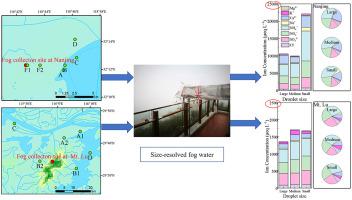Atmospheric Environment ( IF 5 ) Pub Date : 2021-08-12 , DOI: 10.1016/j.atmosenv.2021.118667 Sirui Zhang 1, 2 , Shuxian Fan 1, 2 , Yuan Wang 1, 2 , Panyan Ge 1, 2 , Chunyang Hu 2 , Dandan Zhu 2 , Hongwei Zhang 2

|
The chemical characteristics of fog water are closely related to the droplet size. This study used a three-stage Caltech Active Strand Cloud Collector (CASCC) to collect 170 size-resolved fog samples from eight fog events in the winter of 2013–2017 at an urban site in Nanjing and the summit of Mt. Lu. The pH, electrical conductivity (EC), and inorganic ion concentration were analyzed, and the sources of pollutants in size-dependent droplets were discussed according to the local emission source type. The pH, EC, total ion concentration (TIC), and ion composition of fog water at Nanjing were dependent on the droplet size. The TIC of fog water at Nanjing was approximately 10 times that measured at Mt. Lu. The concentration of different chemical species in the droplet was also size-dependent: Ca2+ concentration was higher in larger droplets with the diameter (D) ≥ 22 μm, whereas SO42−, NO3−, and NH4+ concentrations were higher in smaller droplets with D ranging 4–16 μm. The ion concentration of fog water at Mt. Lu first decreased then increased as the fog developed. Owing to the faster drop rate of larger droplets, coarse particles (2.5–10 μm) exhibited a faster response to fog removal, and the final mass concentration of fine particles (<2.5 μm) decreased the most due to competition between deposition and gravity. Different pollution sources exhibited different contribution rates to the chemical components of size-dependent droplets. Soil sources mainly affected the Ca2+ content of large droplets, whereas industrial sources and vehicles affected the NO3− and SO42− concentrations of medium and small droplets. Soil sources, industrial sources, and vehicles were the main sources of fog water at the urban site in Nanjing, whereas industrial sources, vehicles, soil sources, biomass combustion, and secondary aerosols were the main sources of fog water at the summit of Mt. Lu.
中文翻译:

南京市区及庐山山顶大小分辨雾水化学特征
雾水的化学特性与雾滴大小密切相关。本研究使用三级加州理工学院主动链云收集器 (CASCC) 从 2013-2017 年冬季在南京城市站点和庐山山顶的八次雾事件中收集了 170 个大小分辨雾样本。分析了 pH 值、电导率 (EC) 和无机离子浓度,并根据当地排放源类型讨论了尺寸相关液滴中污染物的来源。南京雾水的 pH、EC、总离子浓度 (TIC) 和离子组成取决于液滴大小。南京雾水的 TIC 大约是庐山的 10 倍。液滴中不同化学物质的浓度也与尺寸有关:Ca 2+直径 ( D ) ≥ 22 μm 的较大液滴中的浓度较高,而D较小的液滴中SO 4 2−、NO 3 -和 NH 4 +浓度较高范围 4–16 μm。随着雾的发展,庐山雾水离子浓度先降低后升高。由于较大液滴的下降速度较快,粗颗粒(2.5-10 μm)对除雾的响应速度较快,而细颗粒(<2.5 μm)的最终质量浓度由于沉积和重力之间的竞争而下降幅度最大。不同的污染源对尺寸相关的液滴的化学成分表现出不同的贡献率。土壤源主要影响大液滴的Ca 2+含量,而工业源和车辆影响NO 3 -和SO 4 2-中小液滴的浓度。南京市区雾水的主要来源是土壤源、工业源和车辆,而珠穆朗玛峰顶峰雾水的主要来源是工业源、车辆、土壤源、生物质燃烧和二次气溶胶。鲁。



























 京公网安备 11010802027423号
京公网安备 11010802027423号